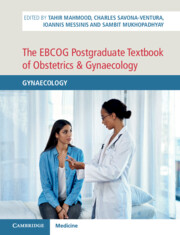Book contents
- The EBCOG Postgraduate Textbook of Obstetrics & Gynaecology
- The EBCOG Postgraduate Textbook of Obstetrics & Gynaecology
- Copyright page
- Dedication
- Contents
- Videos
- Contributors
- Preface
- Section 1 Basic Sciences in Gynaecology
- Section 2 Menstrual Disorders
- Section 3 Reproductive Endocrinology and Infertility
- Section 4 Contraception and STIs
- Section 5 Post-Reproductive Care
- Section 6 Vulva and Vagina
- Section 7 Cervix
- Section 8 Uterus
- Section 9 Ovary and Fallopian Tubes
- Section 10 Operative Gynaecology
- Chapter 43 Basic Hysteroscopy
- Chapter 44 Advanced Hysteroscopy
- Chapter 45 Basic Laparoscopic Gynaecological Procedures
- Chapter 46 Advanced Laparoscopic Gynaecological Procedures
- Chapter 47 Robotic Gynaecological Surgery
- Chapter 48 Myomectomy
- Chapter 49 Hysterectomy for Benign Conditions
- Chapter 50 Reversal of Sterilization in Females and Males to Restore Fertility
- Section 11 Public Health Issues in Gynaecology
- Section 12 Miscellaneous
- Index
- Plate Section (PDF Only)
- References
Chapter 44 - Advanced Hysteroscopy
from Section 10 - Operative Gynaecology
Published online by Cambridge University Press: 24 November 2021
- The EBCOG Postgraduate Textbook of Obstetrics & Gynaecology
- The EBCOG Postgraduate Textbook of Obstetrics & Gynaecology
- Copyright page
- Dedication
- Contents
- Videos
- Contributors
- Preface
- Section 1 Basic Sciences in Gynaecology
- Section 2 Menstrual Disorders
- Section 3 Reproductive Endocrinology and Infertility
- Section 4 Contraception and STIs
- Section 5 Post-Reproductive Care
- Section 6 Vulva and Vagina
- Section 7 Cervix
- Section 8 Uterus
- Section 9 Ovary and Fallopian Tubes
- Section 10 Operative Gynaecology
- Chapter 43 Basic Hysteroscopy
- Chapter 44 Advanced Hysteroscopy
- Chapter 45 Basic Laparoscopic Gynaecological Procedures
- Chapter 46 Advanced Laparoscopic Gynaecological Procedures
- Chapter 47 Robotic Gynaecological Surgery
- Chapter 48 Myomectomy
- Chapter 49 Hysterectomy for Benign Conditions
- Chapter 50 Reversal of Sterilization in Females and Males to Restore Fertility
- Section 11 Public Health Issues in Gynaecology
- Section 12 Miscellaneous
- Index
- Plate Section (PDF Only)
- References
Summary
The improvements in techniques, endoscopic instrumentation and surgical experience have completely changed the approach to uterine intracavitary pathologies, allowing the physician to achieve more reliable diagnostic and therapeutic results. The advent of these new technologies allows us today to improve advanced hysteroscopic surgery by increasing the efficacy of an operating room environment but avoiding the need for the inpatient setting for most of the procedures. It is possible to treat severe cervical stenosis or intrauterine synechiae, including Asherman’s syndrome, G2 myomas, congenital uterine malformations, adenomyosis and chronically retained products of conception in an ambulatory setting. The future looks to further the simplification of instrumentation, and establish a safer and easier delivery of energy sources.
This chapter provides a description of advanced hysteroscopic procedures and their benefits in modern gynaecological practice.
- Type
- Chapter
- Information
- The EBCOG Postgraduate Textbook of Obstetrics & GynaecologyGynaecology, pp. 385 - 396Publisher: Cambridge University PressPrint publication year: 2021

